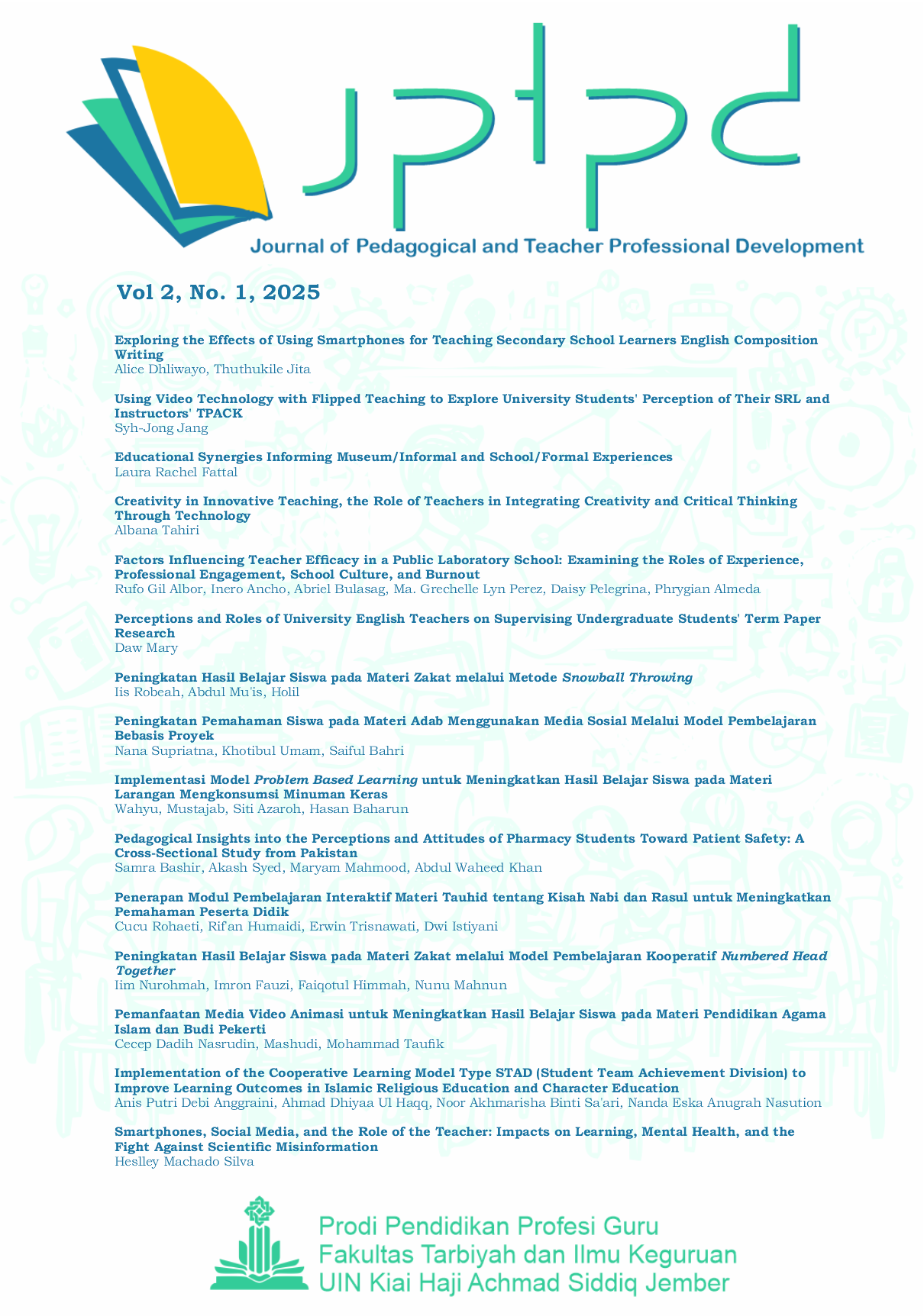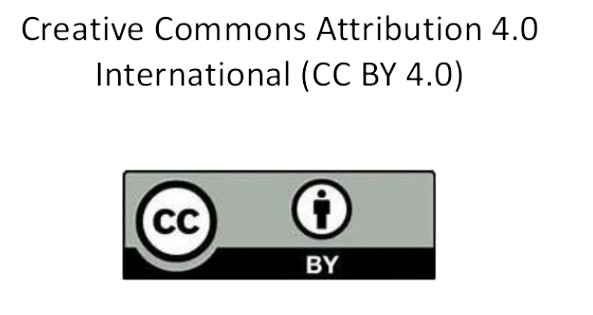Exploring the Effects of Using Smartphones for Teaching Secondary School Learners English Composition Writing
DOI:
https://doi.org/10.35719/jptpd.v2i1.245Keywords:
Affective, Attitude, Gender neutral, Integration, Performance, Smartphone use in schoolsAbstract
There are well known requisites for further studies after Ordinary Level in Zimbabwe that are negatively impacted by traditional pedagogical practices, giving rise to the need for new methods for mitigation. For Zimbabwean learners, a full O level certificate must include English language, yet it is the most failed subject. Through the lens of the theory of Network Society, this study explored the effects of integrating smartphones for technology integration on high school learners’ performance and affective learning in English composition writing. A quasi-experimental case study design with a three-step process was followed. In Step 1, a pre-test was administered to 104 purposively selected learners as well as a questionnaire on attitude. In Step 2, 52 learners became the control class and 52 the experimental class, who were subjected to smartphone-integration learning in English composition writing. Step 3 involved administering a post-test to both groups. Data was analysed using thematic analysis, ANOVA, ANCOVA and t-tests with results revealing that the experimental class developed positively affectively and in performance. The smartphone method improved performance regardless of gender. With an above 84% smartphone penetration and an information and communication technology (ICT) tools shortages in public schools. In line with these findings, teachers of English composition writing may adapt the smartphone for integration to improve learner performance.
References
Al-Saadi, Z., & Heidari-Shahreza, M. (2020). Gender differences in writing: The mediating effect of language proficiency and writing fluency in text quality. Cogent Education, 7(1), 1770823. https://doi.org/10.1080/2331186X.2020.1770923
AlTameemy, F. (2017). Mobile phones for teaching and learning: Implementation and students’ and teachers’ attitudes. Journal of Educational Technology Systems, 45(3), 436–451. https://doi.org/10.1177/0047239516659754
Armstrong, P. (2016). Bloom’s taxonomy. Vanderbilt University Center for Teaching. http://cft.vanderbilt.edu/guides-sub-pages/blooms-taxonomy/.
Bachore, M. M. (2015). Language learning through mobile technologies: An opportunity for language learners and teachers. Journal of Education and Practice, 6(31), 50−53. https://files.eric.ed.gov/fulltext/EJ1083417.pdf
Bakar, K. A., Tarmizi, R. A., Mahyuddin, R., Elias, H., Luan, W. S., & Ayub, A. F. M. (2010). Relationships between university students’ achievement motivation, attitude and academic performance in Malaysia. Procedia – Social and Behavioral Sciences, 2(2), 4906–4910. https://doi.org/10.1016/j.sbspro.2010.03.793
Barnwell, P. (2016, April 27). Do smart phones help or hurt children? The Atlantic. https://www.theatlantic.com/education/archive/2016/04/do-smartphones-have-a-place-in-the-classroom/480231/
Chirume, E., & Ofori-Attah, K. (2016). A better understanding of the access to education through online learning in the case of Zimbabwe. International Journal of Advanced Research, 4(7), 2037–2047. https://doi.org/10.21474/IJAR01/1090
Chitiyo, R., & Harmon, S. W. (2010). An analysis of the integration of instructional technology in pre-service teacher education in Zimbabwe. Educational Technology Research and Development, 57(6), 807–830. https://doi.org/10.1007/s11423-009-9136-7
Chun, D. M. (2016). Language learning & technology. Journal of Language Learning and Technology, 20(2), 98–115. http://dx.doi.org/10125/44463
Creswell, J. W. (2009). Research design: Quantitative, qualitative and mixed methods approaches. Sage Publications.
Creswell, J. W. (2014). Research design: Qualitative, quantitative, and mixed methods approaches (14th ed.). Sage Publications.
Creswell, J. W., & Plano Clark, V. L. (2007). Designing and conducting mixed methods research. Sage Publications
Dondofema, T., & Shumba, M. (2018). Challenges of using ICT in the teaching and learning of English language: A case of Harare Northern Central District of Harare Metropolitan Province: Zimbabwe. International Journal of Research in Social Sciences, 8(8), 108–114.
Dzinotyiweyi, M., & Taddese, A. (2020). EdTech in Zimbabwe: A rapid scan (Country Scan No. 4). EdTech Hub. https://docs.edtechhub.org/lib/G4UUX5P3
FinScope consumer survey report: Zimbabwe 2022. (n.d.) https://finmark.org.za/Publications/FinScope_Consumer_Zimbabwe_2022_Report.pdf
Hung, H.-T. (2017). The Integration of a student response system in flipped classrooms. Language Learning & Technology, 21(1), 16–27. http://llt.msu.edu/issues/february2017/hung.pdf
Joyce-Gibbons, A., Galloway, D., Mollel, A., Mgoma, S., Pima, M., & Deogratias, E. (2017). Mobile phone use in two secondary schools in Tanzania. Education Information Technology, 34(1), 1–20. https://doi.org/10.1007/s10639-017-9586-1
Kangara, T. C., Gocha, M., Tsokota, T., & Marovha, T. (2022). Assessing readiness for teaching and learning using ICTs in Zimbabwean secondary schools in Gweru District, Zimbabwe. Research Square. https://doi.org/10.21203/rs.3.rs-1652431/v1
Kolikant, Y. B. (2010). Digital natives, better learners? Students’ beliefs about how the Internet influenced their ability to learn. Computers in Human Behavior, 26(6), 1384–1391. https://doi.org/10.1016/j.chb.2010.04.012
Lenhart, A., Ling, R., Campbell, S., & Purcell, K. (2010 February, 03). Social media and mobile internet among teens and young adults. https://www.researchgate.net/publication/286376855_Social_Media_Mobile_Internet_Use_Among_Teens_and_Young_Adults
Madden, M., Lenhart, A., Duggan, M., Cortesi, S., & Gasser, U. (2013 March, 13). Teens and technology. Pew Internet. https://www.pewresearch.org/internet/2013/03/13/teens-and-technology-2013/
Manyeredzi, T., & Mpofu, V. (2022). Smartphones as digital instructional interface devices: The teacher’s perspective. Research in Learning Technology, 30. https://doi.org/10.25304/rlt.v30.2639
Mbofana, A., & Banda, S. (2022). The effects of class size on the delivery of quality mathematics learning in secondary schools. Humanities Southern Africa, 2(1), 16−33.
McKim, C. A. (2017). The value of mixed methods research: A mixed methods study. Journal of Mixed Methods Research, 11(2), 202–222. https://doi.org/10.1177/1558689815607096
Mensah, J. K., Okyere, M., & Kuranchie, A. (2013). Student attitude towards mathematics and performance: Does the teacher attitude matter. Journal of Education and Practice, 4(3), 132–139.
Musarurwa, C. (2011). Teaching with and learning through ICTs in Zimbabwe’s teacher education colleges. US–China Education Review A, 12, 1–8. https://files.eric.ed.gov/fulltext/ED529913.pdf
Peng, S., Yang, A., Cao, L., Yu, S., & Xie, D. (2017). Social influence modeling using information theory in mobile social networks. Information Sciences, 379, 146–159. https://doi.org/10.1016/j.ins.2016.08.023
Phillips, C. (2014, November 20). How smartphones revolutionized society in less than a decade. Chattanooga Times (TNS). https://www.govtech.com/products/how-smartphones-revolutionized-society-in-less-than-a-decade.html
Prasad, G. N. R. (2021). Evaluating student performance based on Bloom's taxonomy levels. Journal of Physics Conference Series, 1797, 012063. https://doi.org/10.1088/1742-6596/1797/1/012063
Rasheed, T., Rasheed, M., & Shahida, I. (2019). The role of smartphones in learning English: A study of learners’ perspectives [Conference session]. International Conference on Research in Humanities, March 7–9 2019, London. https://www.dpublication.com/wp-content/uploads/2019/03/ICRH-1-232.pdf
Reilly, D., Neumann, D., & Andres, G. (2018). Gender differences in reading and writing achievement: Evidence from the National Assessment of Educational Progress (NAEP). American Psychologist, 74(4), 445–458. https://doi.org/10.1037/amp0000356
Sengei, W. (2021). Heads of department's role in implementation of history syllabi at selected Zimbabwean secondary schools: An instructional leadership perspective. https://scielo.org.za/pdf/yt/n25/08.pdf
Stalder, F. (2006). Manuel Castells: The theory of the network society. Polity.
Sung, Y. T., Chang, K. E., & Liu, T. C. (2016). The effects of integrating mobile devices with teaching and learning on students’ learning performance: A meta-analysis and research synthesis. Computers & Education, 94, 252–275. https://doi.org/10.1016/j.compedu.2015.11.008
Teig, N., & Nilsen, T. (2022). Profiles of instructional quality in primary and secondary education: Patterns, predictors, and relations to student achievement and motivation in science. Studies in Educational Evaluation, 74, 101170. https://doi.org/10.1016/j.stueduc.2022.101170
Thomas, K., & Muñoz, M. A. (2016). Hold the phone! High school students' perceptions of mobile phone integration in the classroom. American Secondary Education, 44(3), 19–37. https://www.proquest.com/docview/1812537943?pqorigsite=gscholar&fromopenview=true
UNESCO. (2012). Turning on mobile learning: Global themes. UNESCO working paper series on mobile learning. http://unescodoc.unesco.org/images/0021/002164/216451E.pdf
UNICEF. (2017). Generation 2030 Africa 2.0. https://data.unicef.org/wp-content/uploads/2017/10/Generation_2030_Africa_2.0_25Oct17_e-version.pdf
UNICEF. (2020). Zimbabwe child poverty report 2019. https://www.unicef.org/zimbabwe/reports/zimbabwe-child-poverty-report-2019
Verona, L., Oliveira, J., da Cunha Hisse, J., Machado Campos, M. L. (2018). Metrics for network power based on Castells’ network theory of power: A case study on Brazilian elections. Journal of Internet Services and Applications, 9, 23 https://doi.org/10.1186/s13174-018-0092-5
World Bank. (2020). Guidance note on remote learning and COVID-19 (English). World Bank Group. https://documents1.worldbank.org/curated/en/531681585957264427/pdf/Guidance-Note-on-Remote-Learning-and-COVID-19.pdf
Zimbabwe MoPSE (Ministry of Primary and Secondary Education). (n.d.). Curriculum Framework for Primary and Secondary Education: 2015–2022. http://mopse.co.zw/sites/default/files/public/downloads/Zim_Curriculum_Framework.pdf
ZIMSEC. (2017). An analysis of the November 2016 Ordinary Level examination results. https://www5.zimsec.co.zw/ordinary-level-results-analysis-june-2017-examinations/
ZIMSEC. (2019). The English examination structure–updated 2021–updated 2024. https://revision.co.zw/the-english-language-examination-structure/
Zindi, F., & Ruparanganda, F. (2011). Evaluation of barriers to the integration of ICT in teaching and learning of science and mathematics in Zimbabwe’s secondary schools. Zimbabwe Journal of Educational Research, 23(3), 222–236. https://opendocs.ids.ac.uk/opendocs/handle/20.500.12413/7162
Downloads
Published
How to Cite
Issue
Section
License
Copyright (c) 2025 Journal of Pedagogical and Teacher Professional Development

This work is licensed under a Creative Commons Attribution 4.0 International License.











